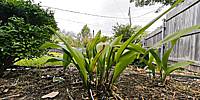
Family Botany
Fort Worth, Texas, USA
June 24, 2011, 10:10 am Central Texas Time (GMT -6)
© 2011 Dave Albright, All Rights Reserved.
This family of Cast-Iron Plants was recommended and planted by Baldi Gardens, Arlington, Texas.
Partial quote from Union County College Biology Department —Dr. T. Ombrello
Union County College 1033 Springfield Avenue, Cranford, NJ 07016
"Common Name: Cast-Iron Plant, Iron Plant, Barroom Plant
Scientific Name: Aspidistra Elatior. Aspidistra — Greek, meaning "small round shield", describing the stigma (the pollen receiving portion of the flower). Elatior — Latin, meaning "taller".
As the various common names suggest, the cast-iron plant is one tough species. It ranks right up there with snake plants and philodendrons as being an almost indestructible houseplant. Capable of surviving under low light conditions coupled with extremes of temperatures and irregular watering, it's the perfect plant for those individuals who cannot seem to keep plants alive indoors.
This native of China is admittedly a plain-looking plant. Its slow-growing, but long-lived leaves are dark green and grow right out of the soil to a height of about 2 feet. The stems remain just below the soil surface and thrive even in a small pot of poor soil.
As a member of the Lily family of plants (Liliaceae), one might expect the cast-iron plant to have showy flowers like many of its relatives (day-lilies, tulips, and hyacinths). Cast-iron plant flowers, however, are quite modest and are often overlooked even when in full bloom. A dull brown-purple in color, the one-inch flowers appear at the soil surface and are often hidden by the foliage. A small, dark, one-seeded berry may follow the bloom.
The plant can be vegetatively propagated with ease. Removed from its pot, the stems can be sectioned into pieces with a few leaves and some roots. Each piece, when potted will slowly but surely yield a new plant. Introduced into Europe and then America over 100 years ago as an ornamental, the cast-iron plant was utilized extensively during Victorian times as a parlor plant. It was considered by some to be a lower-middle class plant, and has gone in and out of fashion over the years since then. By no means a tropical houseplant, cast-iron plants survive near the Himalayas. The species has been used extensively in the southern US as a ground-cover under large trees."
This family collection of 15 Cast-Iron plants really do survive in a shaded area, that is infrequently watered "hence Xeriscape qualifying plantings".
To provide additional shade from the very hot Texas summers, planted among the Cast-Iron plants are small leaf Nandian Shrubs. The Nandina Plant is an excellent choice for desert landscaping. Also called Heavenly or Sacred bamboo. Once established it is drought tolerant and very slow growing. It can take full sun or partial shade. Good for narrow spaces. It is an evergreen. Grows to 6 to 8 feet tall, 3 feet wide. Seed grown. There are numerous varieties like the gulf stream, plum passion, sienna sunrise, harbour belle and others.
Classification:
Family Berberidaceae – Barberry family
Genus Nandina Thunb. – nandina
Species Nandina domestica Thunb. – sacred bamboo
Lat: 32° 39' 37.68" N
Long: 98° 23' 16.42" W
Elevation: 769 feet above Mean Sea Level
Precision is: Unknown / Undeclared.


 Tap or click the zoom icon in the bottom right corner of the picture to switch between in-page and fullscreen view
Tap or click the zoom icon in the bottom right corner of the picture to switch between in-page and fullscreen view